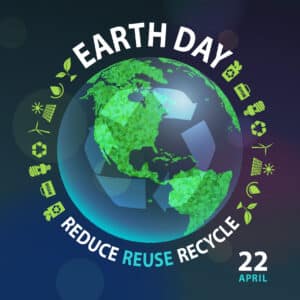“Our Power, Our Planet” is the theme of this year’s Earth Day on April 22, 2025.
In addition to the annual commemoration of efforts to focus on environmental issues, the theme in 2025 is increasing clean energy and improving air quality. The recycling industry has long been at the forefront of efforts to protect the environment and reduce energy consumption.
Earth Day 2025
Every year Earth Day has a different theme and 2025’s theme, Our Power, Our Planet, is to increase the focus on encouraging renewable energy production. Events across the world and in the United States give people the opportunity to participate in outdoor activities and celebrate Earth Day.
Organizations from the National Park Service to the Nature Conservancy list events on their websites taking place throughout the country. The U.S. Environmental Protection Agency has posted a “Making Earth Day Every Day” infographic on its website with ideas and recommendations from saving energy and water to increasing recycling and keeping food out of landfills.
History of Earth Day
Earth Day is an annual commemorative day set aside to promote efforts and educate people about the health of planet Earth. According to the website “National Today,” it was established 55 years ago in the wake of an environmental catastrophe. In 1969, a massive oil spill occurred off the coast of Santa Barbara. California. U.S. Senator Gaylord Nelson from Wisconsin led the effort calling all Americans to focus on environmental protection. The outpouring of support led to the creation of Earth Day in 1970. Subsequently, the effort led to the creation of the Environmental Protection Agency (EPA) and enactment of the Clean Air Act, Clean Water Act and Endangered Species Acts.
Earth Day serves as a reminder of how fragile our ecosystem is and calls on people to be mindful of how their habits impact the environment. An important aspect of Earth Day is that everyone can play a role in its mission, no matter how small, be it picking up litter or turning off lights when you leave a room.
Recycling industry’s role in improving the environment
The recycling industry has long been at the forefront of practices to improve the environment. Recycling both reduces pollution and conserves natural resources while at the same time saving energy.

First, recycling reduces the amount of material sent to landfills. By keeping hazardous materials from entering landfills, cleaner air and water is the result. By reusing recycled material to manufacture new products, there is less demand for new material derived from natural resources. For instance, there is less demand for mining new ore, cutting down trees for paper or using more fossil fuels to produce new plastic, thereby conserving valuable natural resources.
Finally, the use of recycled material conserves energy. Scrap recycling reduces greenhouse gas emissions by requiring significantly less energy to manufacture products from recyclables than virgin materials. This energy savings translates into an enormous reduction of carbon dioxide emissions. According to the Recycled Materials Association (ReMA), the scrap commodities recycled annually save the equivalent of nearly 400 million tons of carbon dioxide, equal to the energy use of 48 million homes for one year.
The ReMA website highlights additional examples of energy savings and conservation impacts of recycling:
- Plastic – Using recycled plastics in manufacturing saves up to 88 percent of the energy needed to produce plastic from virgin material. Recycling one ton of plastic bottles reduces greenhouse gas emissions by 3,380 pounds, the equivalent of 173 gallons of gas.
- Glass – For every ton of glass recycled, more than one ton of raw material is saved.
- Non-ferrous metals – Non-ferrous metal recycling is highly efficient and dramatically conserves natural resources. U.S. recycling recovers 85 to 95 percent of all aluminum in U.S. automobiles. Aluminum manufacturing is extremely energy intensive, so that manufacturing products from recycled aluminum saves up to 95 percent of the energy needed to manufacture them from virgin material.
- Ferrous metals – Ferrous scrap made from iron and steel is the most recycled material in the United States and the world. The largest source of this scrap in the U.S. is old automobiles, which provide 13 million tons of iron and steel scrap per year. Recycling this material versus creating new material saves the equivalent energy necessary to power 18 million homes for one year. Producing new steel from ferrous scrap requires 60 percent less energy and reduces CO2 emissions 58 percent compared with producing steel from virgin materials.
As people around the globe participate in events to support taking care of our planet, the recycling industry continues its ongoing efforts to contribute to a cleaner environment. And with efforts to keep waste out of landfills, reduce energy consumption and preserve natural resources, every day is Earth Day at scrap metal recycling plants.
About ScrapWare Corporation: Since 1989, Rockville, Maryland-based ScrapWare Corporation has been the software of choice for the recycling industry. Its ease of installation and simplicity saves users time and money while helping them achieve compliance and maintain accurate business insights. With state-of-the-art functionality tailored to each organization’s unique requirements, ScrapWare is an advanced dynamic software solution that alleviates the most pressing recycling industry worries. For more information, please call (301) 517-8500 or visit https://www.scrapware.com/.

